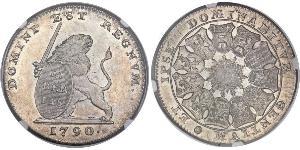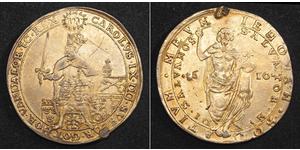1 Ducaton (продана за $321.0)
1734, Netherlands, Gelderland. Large Silver Rider (Ducaton) of 60 Stuivers. R!
Mint Date: 1734
Province: Overyssel
Reference: Davenport 1824, KM-95.3. R!
Denomination: Ducaton of 60 Stuivers (Silver Rider)
Condition: Cleaned with dark oxidation tone areas, light salt water dmage (lightly rough surfaces) otherwise about XF!
Diameter: 43mm
Material: Silver
Weight: 32.5gm
Obverse: Armored knight on horse, brandishing sword on jumping horse right. Crowned shield with arms of Utrecht below.
Legend: MO : NO : ARG : CONF : BELG : D : GEL . & . C . Z .
Reverse: Crowned shield with, supported by crowned roaring lions. Date (1734) within foliage below.
Legend: CONCORDIA RES PARVAE . CRESCUNT . *
Hollandia was a ship of the Dutch East India Company (VOC) which wrecked on Annet, Isles of Scilly on 13 July 1743 causing 276 fatalities. The wreck was discovered in 1971 by Rex Cowan, a London attorney. Hollandia was built by the Dutch East India Company in 1742 in Amsterdam to a new design, as a 32 gun, 700 ton ship with a length of 42 metres (138 ft). On 3 June 1743 she left Texel as part of a Batavia bound fleet carrying a large amount of trade coin and several important passengers. On 13 July 1743 she became separated from the fleet and struck Gunner Rock near Annet, Isles of Scilly in the early hours of the morning, sinking nearby with the loss of all hands. Rex Cowan began his search for Hollandia in 1968, starting with Dutch and English archives and using advanced (for the time) equipment such as a proton magnetometer, finally locating the wreck on 16 September 1971. A large quantity of coins were recovered, as well as bronze cannons and mortars.
In 1659 the Dutch states started production of the 'silver rider' ducaton, featuring a mounted knight on horseback. This design weighing 32.779 grams of 0.941 silver also featured the crowned arms of the United Netherlands on the reverse, with a shield below the knight indicating the province of minting. Rider ducatons were minted until 1798. In the period 1726-1751 ducatons were minted bearing the monogram of the Dutch East India Company. As a trade coin the familiar design of the Dutch rider helped it to compete against well-known world coins such as the Spanish dollar. It was valued at 60 stuivers.
The Republic of the Seven United Netherlands (or "of the Seven United Provinces") (Dutch Republic or United Provinces in short, Foederatae Belgii Provinciae or Belgica Foederata in Latin) was a European republic between 1581 and 1795, in about the same location as the modern Kingdom of the Netherlands, which is the successor state.
Before 1581, the area of the Low Countries consisted of a number of duchies, counties, and independent bishoprics, some but not all of them part of the Holy Roman Empire. Today that area is divided between the Netherlands, Belgium, Luxembourg and parts of France and Germany. The Low Countries in the 16th century roughly corresponded to the Seventeen Provinces covered by the Pragmatic Sanction of 1549 of Holy Roman Emperor Charles V.
Through marriage, war or sale, these states were acquired by the Habsburg emperor Charles V and his son, king Philip II of Spain. In 1568, the Netherlands, led by William I of Orange, revolted against Philip II because of high taxes, persecution of Protestants by the government, and Philip's efforts to modernize and centralize the devolved medieval government structures of the provinces. This was the start of the Eighty Years' War.
In 1579, a number of the northern provinces of the Netherlands signed the Union of Utrecht, in which they promised to support each other in their defence against the Spanish army. This was followed in 1581 by the Act of Abjuration, the declaration of independence in which the provinces officially deposed Philip II.
The United Provinces first tried to choose their own lord, and they asked the Duke of Anjou (sovereign from 1581-1583) to rule them. Later, after the assassination of William of Orange (July 10, 1584), both Henry III of France and Elizabeth I of England declined the offer of sovereignty. However, the latter agreed to turn the United Provinces into a protectorate of England (Treaty of Nonsuch, 1585), and sent the Earl of Leicester as governor-general. This was not a success, and in 1588 the provinces became a Republic.

|
Добавив:
anonymous 2014-01-29 |
|
||
|
||
|
||
|
||
1 Riksdaler Швеція Золото
в групі 2 монет / 1 цін
⇑
250 Філс Ірак Нікель
в групі 2 монет / 1 цін
⇑

-600-300-P5kKb0OMZ7UAAAFDno7A4OBd.jpg)

-300-150-4pkKbzbi4qcAAAFN0FFtvxJL.jpg)
 Deutsch
Deutsch Русский
Русский Українська
Українська English
English Italiano
Italiano Français
Français Español
Español 汉语
汉语














